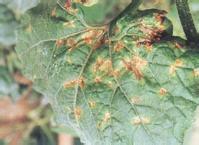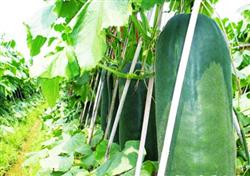There are many diseases and insect pests of wax gourd local varieties that need to be strengthened.

First, the main local varieties of wax gourd Changsha powder wax gourd: medium-late mature varieties, white wax powder on the surface, long cylinder-shaped, hanging flesh, flat seeds. Melon length 87 cm, melon can reach more than 25 kg, suitable for urban suburbs and large wax gourd base planting. Powder peel Biandan wax gourd: medium and late ripening variety, with white wax powder on the surface, extra-long cylindrical shape (flat stretcher). The melon is about 102 cm long and 16 cm in transverse diameter, with a small inner cavity and hanging flesh. Generally, a single melon weighs about 14 kilograms, and a large melon can reach 25 kilograms, which is most suitable for cultivation in the suburbs of cities and towns. Changsha green wax gourd: late-maturing variety, stem climbing, medium growth potential and branching. The first female flower is in the 24th-26th node of the main vine. Melon long cylindrical shape, melon skin dark green, smooth. The single melon weighs 15,30kg and takes about 140 days from sowing to harvest. It has strong heat and drought resistance, wide regional adaptability and lax requirements for light conditions. Guangdong black wax gourd: medium-ripe variety, medium-fruit type. The first female flower appeared in the 18 ~ 20 segments of the main vine, and the two female flowers were 4-6 nodes apart. Sowing in March in Changsha; it takes about 70 days from emergence to the first female flower. The fruit is shell-shaped, dark green and hairy. The melon is about 58 cm long and 19 cm thick. The texture is dense, the flesh is thick, the cavity is small, the flavor is good, and the flesh is scattered. A single melon weighs about 12 kilograms. Like fertilizer, pay attention to using grass or rattan to protect the fruit shoulder in late summer and early autumn, so as not to burn the sun and affect the commodity. It is suitable for cultivation in north and south spring and autumn. Second, the main diseases of wax gourd and its control: 1. Blight. The incidence of high temperature and humidity is serious, which often occurs in the early growth stage of wax gourd. The disease mainly occurred in leaves, stem nodes and fruits, showing water-immersed disease spots. 2. Anthrax. Mainly occurred in the leaves, the site of the disease was dark brown irregular small blocks. 3. Fruit rot. It mainly occurs on the wax gourd fruit, which is immersed in water at the beginning of the disease, and then grows white mildew, wax gourd soft cotton rot, high temperature and rain and the whole fruit development period. 4. Fusarium wilt. It mostly occurs on the stems and leaves, and the disease site turns yellow and wilts, mainly in the late growth stage of wax gourd. Cultivation control: in the early stage of growth, pay attention to clear ditch drainage, so that "border, waist, circumference" three ditches matching, there is no stagnant water in the ditch, rain stop ditch dry. Ploughing, topdressing and weeding in time. During the whole growth period, 1 ∶ 0.5: 0.8 ∶ 240300 times Bordeaux solution was used for comprehensive disease prevention for 3 times and 5 times. Pay attention to rotation and avoid continuous cropping. It is not suitable to choose the land where the previous crops are melons to grow wax gourd. Proper application of lime in the planting land to reduce pathogens. Disease resistant varieties were selected. Rational fertilization, increase the application of organic fertilizer, topdressing should be uniform, not excessive topdressing of high concentration of available nitrogen fertilizer. Chemical control: at seedling stage, vine stage and early flowering and fruiting stage, 50% carbendazim 800-fold solution or 75% chlorothalonil 500-fold solution was sprayed respectively to control blight, and Kelu, metalaxyl mancozeb and metalaxyl copper could also be used to control blight. Carbendazim, methyl topiramate, copper oxychloride, methomyl, chlorothalonil and so on can be used for the prevention and treatment of anthracnose. Agricultural resistance 120, methyl topiramate, Shuangxiaoling, Kangkuning and so on can be used to control Fusarium wilt. The fungicides for the control of fruit cotton rot are basically the same as those of blight. Third, the main insect pests of wax gourd and its control are mainly melon silk borer, red spider, aphid, yellow (black) gourd, thrips and so on. Melon silk borer mainly harms leaves and flowers, spinning curls melon leaves and hides them. The red spider mainly harms the leaves, which is located on the back of the leaves and is small in size. Aphids harm the middle and upper leaves and stem tips, yellow (black) melon harms leaves, thrips harm stem tips, tender leaves and tender melons. Pesticides such as dimethoate, aldicarb, imidacloprid, aldicarb and pyrethroids can be used to control aphids; propargite, acarb, nisoran and methotrexate can be used to control red spiders; phoxim, phoxim, Badan and pyrethroids can be used to control melon silk borer; trichlorfon and pyrethroids are used to control yellow (black) melons; Shachongshuang, Badan, Qixingbao and dimethoate are used to control thrips. When good insects, red spiders and melon silk borer occur at the same time, it can be controlled by killing broth and so on. Spray in time at the initial stage of insect pests, and increase the number of spraying times during the peak period, usually once every 4-5 days. Due to the rapid renewal of pesticide varieties and more product names, vegetable farmers should choose corresponding new pesticide products when purchasing pesticides, in order to ensure the safety of drug use to achieve the best control effect.
- Prev

Symptoms and control methods of wax gourd angular spot
Symptoms: mainly damage to leaves, petioles and fruits. It can be damaged from seedling stage to adult stage. True leaf infection, initially a bright green flooding spot, gradually light brown, disease spot limited by the vein of the leaf is polygonal, yellowish brown, when the humidity is high, the back of the leaf is overflowing with milky white turbid bead-like bacterial pus, and the disease is brittle and easy to perforate. The stem and petiole are infected.
- Next

Identification and control measures of common diseases and insect pests in wax gourd
Spring wax gourd is rich in nutrients, including 96.6 grams of moisture, 0.4 grams of protein, 19 milligrams of calcium, 12 milligrams of phosphorus, 18 milligrams of vitamin C18 and other nutrients per 100 grams of fresh melon. In recent years, the demand for wax gourd is increasing. The yield of spring wax gourd is high, and the yield of some varieties can be as high as 10000 kg.
Related
- Where is it suitable to grow horseradish in China? it is expected to see the middle altitude horseradish in Alishan.
- How to prevent tomato virus disease reasonably? (Control methods included)
- Many people like to plant towel gourd on the balcony. What are the main points of this method and management?
- What crops can chili peppers be mixed with?
- Fertilization techniques and matters needing attention in Tomato
- What are the grafting techniques for peach seedlings in spring?
- Harm and control methods of root swelling disease of Chinese cabbage
- What are the pests of sweet potatoes? How to prevent and cure it?
- Symptoms, causes and Control methods of navel Rot in Tomato
- The cause of "Cucumber rotten bibcock" in Farmers' planting Cucumber and its Control Plan

